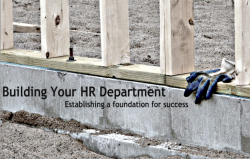I can find admin staff easily enough. However, hiring a person for xyz skilled trade takes forever! I need to find a talent pool to tap into, but so far nothing!!!!!! Rebecca
The comment above was a piece of a recent conversation with a friend and reader up in Canada. We chat back and forth occasionally about recruiting topics, and I told her I would discuss the concept of finding/developing/building a talent pool for a skilled individual. I don’t know it all, but here’s how I have been able to develop a talent pool in an area that most would say is pretty tough to break into.
First, find one
It’s a much easier proposition if you have one to start from. Preferably a current employee or friend, because you’re going to be asking them a lot of (seemingly simple) questions. Occasionally we need to find a “provisioner” for our technical publications team. I’m still not 100% sure what these people do, but I know enough generally to understand if someone has what it takes or not. When I started my first search for one of these openings, I realized how little I knew. So I decided to remedy that situation.
I grabbed one of our current guys with a solid provisioning background and asked him a list of questions:
- What do provisioners do?
- What background makes someone good at provisioning?
- What sort of companies hire provisioners?
- What are some keywords I could use to find a provisioner’s resume?
- Do any schools have provisioning-like degree or certification programs?
- What sort of questions would you ask a provisioner to determine if they are proficient?
Those are a few, but they hit the highlights. I’m building a profile for what a provisioner looks like. Just like the police build a profile for someone in a criminal case based on what they know about the crime combined with statistical data, I do the same thing (minus handcuffs).
Expand that network
As long as you’re asking questions of your existing person, you might as well ask one more: who is the best you’ve ever seen at this job? That’s your #1 target. They won’t always be accessible, but it’s a good place to start. If it doesn’t pan out, leverage that connection into the person’s network. Here’s an example:
Hey, Bob! Glad to hear you’re enjoying your current work. Brian said you were great at what you do, and I’m always glad to see people excelling at what they love. If you ever change your mind or want to talk more, feel free to reach out to me and I’d be happy to discuss a position with you. In the meantime, is there anyone else you know who might be qualified/interested in a position like this?
That serves two purposes. First, it leaves the door open to future opportunities. People hate to shut doors, and I always leave it open, even if just barely, so they always feel comfortable reaching out. It swings both ways, too. If I ever have another opening in their field of expertise, you better believe I’ll be reaching out to find out if they are still happy at work. There have been plenty of times where that conversation turned into a job offer itself.
Always be looking
If you wrap up a hiring action and make an offer to a candidate, hang onto the next few if they are still qualified. You never know when the next batch of candidates might not be as strong as your second best pick this time around. And for everyone who turns you down, they are a potential “in” with a new networking chain.
Get a few champions
I have a few “champions” that I turn to fairly often. These people have great networks and are phenomenal about helping to find new staff, even when there isn’t a bonus or other incentive on the line. Recently I had a guy contact me, and I looked back through the email chain. There were seven connections between our “champion” and this guy. If any one of those people had stopped the chain, the guy would have never found the job. However, because of the credibility of the first guy in the chain, it kept rolling until the right guy saw the email.
As I said earlier, this isn’t the end, it’s just a beginning. Every position, company, and market is different. However, with the right attention to detail and persistence, you can create your own talent pool and rev up your recruiting for months to come.
 Remember…
Remember…
 When looking at teambuilding through that list of requirements, it's easy to see how each of these elements can tie into the plan. Let's break it down to each individual component and discuss each in turn.
When looking at teambuilding through that list of requirements, it's easy to see how each of these elements can tie into the plan. Let's break it down to each individual component and discuss each in turn.